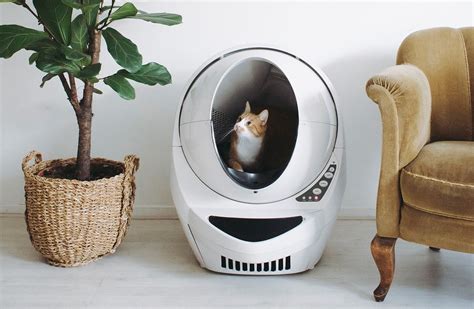The Rise of Self-Cleaning Litter Boxes: A Paradigm Shift in Cat Care
In the throes of technological advancements, the humble litter box has undergone a revolutionary transformation. Enter the robot litter box, a self-cleaning marvel that promises to revolutionize cat ownership by eliminating the chore of daily scooping. These innovative devices employ sensors, rakes, and rotating trays to automate the removal of waste, leaving pet parents with more time to enjoy the company of their feline companions.

Robot Litter Box vs. Traditional Litter Box: A Comparative Analysis
1. Convenience and Hygiene: Robot litter boxes reign supreme in convenience, offering hands-free maintenance that eliminates the need for daily scooping. This not only saves time but also promotes hygiene by reducing exposure to harmful bacteria and unpleasant odors.
2. Waste Management: Automated waste removal ensures that litter boxes remain clean and hygienic, preventing unpleasant smells and attracting insects. This feature is particularly beneficial for cats with sensitive respiratory systems or those living in small spaces.
3. Health Monitoring: Some robot litter boxes are equipped with advanced sensors that monitor a cat’s frequency and duration of use. This data can provide valuable insights into a cat’s health, allowing pet owners to detect potential issues early on.
4. Cost: Robot litter boxes come with a higher initial investment compared to traditional litter boxes. However, their long-term cost-effectiveness can be attributed to reduced litter usage and the elimination of the need for disposable liners.
The Psychology of Cats and Robot Litter Boxes
Introducing a robot litter box into a cat’s environment can evoke a range of behavioral responses. While some cats may embrace the novelty, others may exhibit hesitation or even avoidance. Here are a few factors that can influence a cat’s reaction:
1. Gradual Introduction: Allowing cats to acclimate gradually to the robot litter box can increase the likelihood of acceptance. Start by placing the box near their current litter location and gradually move it to its desired spot over time.
2. Scent and Familiarization: Cats are creatures of habit that rely heavily on scent for navigation and comfort. Introduce the robot litter box with familiar litter and encourage your cat to explore it with treats or catnip.
3. Privacy and Distance: Some cats prefer privacy when using the litter box. Ensure that the robot litter box is placed in a quiet and secluded area where they feel comfortable and undisturbed.
Tips and Tricks for a Seamless Transition
-
Keep the Litter Box Clean: Regularly empty the waste drawer and replace the litter, even if the robot litter box is programmed to clean itself. This ensures that your cat always has a clean and inviting litter area.
-
Monitor Your Cat’s Behavior: Observe your cat’s interactions with the robot litter box. If they exhibit any signs of hesitation, provide reassurance and offer treats as positive reinforcement.
-
Address Concerns Promptly: If your cat consistently avoids the robot litter box, consider potential underlying health issues or environmental stressors. Consult with your veterinarian to rule out any medical conditions.
Common Mistakes to Avoid
-
Forcing the Transition: Avoid forcing your cat to use the robot litter box. Allow them to acclimate at their own pace and provide alternative litter options until they become comfortable.
-
Neglecting Basic Maintenance: While robot litter boxes eliminate daily scooping, they still require regular cleaning and maintenance. Neglecting these tasks can lead to a buildup of waste and unpleasant odors.
Conclusion: Embracing the Feline Future
Robot litter boxes represent the future of cat care, offering convenience, hygiene, and potential health benefits. While not all cats may embrace the technology immediately, with patience and understanding, pet parents can help their furry friends adjust and enjoy the many advantages that come with a self-cleaning litter box. As we move towards 2025 and beyond, we can expect continued advancements in this field, further revolutionizing the way we care for our beloved feline companions.
Table 1: Robot Litter Box Features and Benefits
| Feature | Benefit |
|---|---|
| Automated waste removal | Hands-free maintenance, reduced odor and bacteria |
| Waste monitoring sensors | Early detection of health issues |
| Long-term cost-effectiveness | Reduced litter usage, elimination of disposable liners |
| Gradual introduction | Increased cat acceptance and comfort |
Table 2: Cat Behavioral Responses to Robot Litter Boxes
| Response | Factors Influencing |
|---|---|
| Acceptance | Gradual introduction, familiar scent, privacy |
| Hesitation | Novelty, lack of familiarity, environmental stressors |
| Avoidance | Underlying health issues, discomfort, fear |
Table 3: Tips for a Seamless Transition
| Tip | Purpose |
|---|---|
| Gradual introduction | Allow cat to acclimate at own pace |
| Reward with treats | Reinforce positive use of robot litter box |
| Monitor behavior | Identify any concerns and seek veterinary advice |
Table 4: Common Mistakes to Avoid
| Mistake | Consequence |
|---|---|
| Forcing transition | Increased stress and avoidance |
| Neglecting maintenance | Buildup of waste and unpleasant odors |
| Ignoring behavioral cues | Potential health issues or environmental stressors |





















